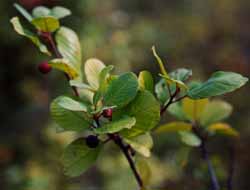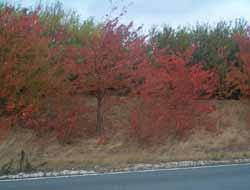|
The term copse is used for any small area of trees,
whether naturally occurring or planted in a corner of a field, or on the
embankment along the new A52. Nowhere now in Bingham are the trees in
a copse actually coppiced.
There is little natural woodland in the parish. One
area is Starnhill Plantation, which is about 0.75 hectare. The oldest
oak in the plantation is around 135 years, but there is map evidence that
the plantation originated some time between 1776 and 1832. It consists
now of a mix of well-established old trees, younger trees, possibly a
result of natural regeneration, and recently planted ones. Elsewhere,
the eastern side of theA46 north from the Saxondale roundabout to the
railway line is a woodland strip that has originated partly by letting
the hedgerow go wild, but with some planting and natural regeneration
of trees. There is a long stretch of naturally generated woodland, mostly
sycamore, in the north-western part of the Linear Park and a grove of
mostly ash, also naturally generated near the parish boundary end of the
Linear Park. Neither these nor any other occurrences on the Linear Park
have been included in this survey. They are dealt with separately.
Dotted around the parish are small clumps of willow around ponds. These
trees, which split and break and are often multi-stemmed, are difficult
to date, but they generally appear to be old. Most are white willow, but
crack willow and osier have been found. A large area of willow is present
on the west side of Chapel Lane near the level crossing.

Alder buckthorn.
Photo: Peter Allen |
In most of the parish the small
copses are the result of deliberate planting by the Crown Estate,
farmers or the county council. These plantings serve as cover for
game birds, wind breaks, for noise absorption along roads and the
railway, for concealment around existing and proposed industrial
development and for purely cosmetic reasons in areas of big fields.
Almost all of them have been planted in the last forty years.
The range of species in these young plantations
is considerable. In some of the plantations up to twenty different
species can be found, including one or two rare types. For example,
the only occurrence of alder buckthorn in the whole parish is in
a thicket planted near the Department of Transport weighbridge,
at Saxondale roundabout. Sweet chestnut and white poplar, neither
of which is common elsewhere, have been planted on the north-west
side of the A52 and Tithby Road crossroads. Except in the churchyard,
cemetery and Robert Miles Junior School, where there is a lot of
it, the only yew to be found is in small cover plantings on Lower
Brackendale Farm. On this farm is the only occurrence so far found
of Italian alder. Grey alder, also quite uncommon, is present in
a copse near the entrance to Holme Farm, near the Margidunum roundabout.
Hornbeam has been planted in several of the small copses north of
the railway line and west of Chapel Lane. Hungarian and Red oak
can also be found here. |
The plantings along the A52 have been quite
imaginative. They range from small groups of a single species to
larger areas of varied species, but in different parts with a different
dominant type. It may be field maple in the eastern end of the by-pass,
or silver birch at the Saxondale end. The effect of this and the
decision to leave areas of grassland between them is to create diverse
habitats in a part of the parish that is rarely disturbed by humans
and dogs. The presence of kestrels hovering over this part is a
good indication that various small mammals probably do well there.
There are three ways of finding
out more about Bingham’s copses. You can search
by area, by species or go directly into the database.
To enter the database and
conduct your own search, click
here. |
 Small planting of cherry
along the A52 in full autumn colour
Small planting of cherry
along the A52 in full autumn colour
Photo: Peter Allen |
|
![]()


